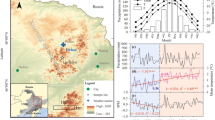Abstract
Dead wood biomass can be a substantial fraction of stored carbon in forest ecosystems, and coarse woody debris (CWD) decay rates may be sensitive to climate warming. We used an elevation gradient in Colorado Rocky Mountain subalpine forest to examine climate and species effects on dead wood biomass, and on CWD decay rate. Using a new radiocarbon approach, we determined that the turnover time of lodgepole pine CWD (340±130 years) was roughly half as long in a site with 2.5–3°C warmer air temperature, as that of pine (630±400 years) or Engelmann spruce CWD (800±960 and 650±410 years) in cooler sites. Across all sites and both species, CWD age ranged from 2 to 600 years, and turnover time was 580±180 years. Total standing and fallen dead wood biomass ranged from 4.7±0.2 to 54±1 Mg ha−1, and from 2.8 to 60% of aboveground live tree biomass. Dead wood biomass increased 75 kg ha−1 per meter gain in elevation and decreased 13 Mg ha−1 for every degree C increase in mean air temperature. Differences in biomass and decay rates along the elevation gradient suggest that climate warming will lead to a loss of dead wood carbon from subalpine forest.



Similar content being viewed by others
References
Arthur MA, Fahey TJ (1990) Mass and nutrient content of decaying boles in an Engelmann spruce-subalpine fir forest, Rocky Mountain National Park, Colorado. Can J For Res 20:730–737
Bronk Ramsey C (1995) Radiocarbon calibration and analysis of stratigraphy: the OxCal program. Radiocarbon 37:425–430
Bronk Ramsey C (2001) Development of the radiocarbon program OxCal. Radiocarbon 43:355–363
Bronk Ramsey C, van der Plicht J, Weninger B (2001) ‘Wiggle Matching’ radiocarbon dates. Radiocarbon 43:381–389
Brown PM, Shepperd WD, Mata SA, McClain DL (1998) Longevity of windthrown logs in a subalpine forest of central Colorado. Can J For Res 28:932–936
Busse MD (1994) Downed bole-wood decomposition in lodgepole pine forests of central Oregon. Soil Sci Soc Am J 58:221–227
Cain WF, Suess HE (1976) Carbon 14 in tree rings. J Geophys Res 81:3688–3694
Chambers JQ, Higuchi N, Schimel JP (1998) Ancient trees in Amazonia. Nature 391:135–136
Chambers JQ, Higuchi N, Schimel JP, Ferreira LV, Melack JM (2000) Decomposition and carbon cycling of dead trees in tropical forests of the central Amazon. Oecologia 122:380–388
Chambers JQ, Schimel JP, Nobre AD (2001) Respiration from coarse wood litter in central Amazon forests. Biogeochemistry 52:115–131
Daniels LD, Dobry J, Klinka K, Feller MC (1997) Determining year of death of logs and snags of Thuja plicata in southwestern coastal British Columbia. Can J For Res 27:1132–1141
Dawson TE, Mambelli S, Plamboeck AH, Templer PH, Tu KP (2002) Stable isotopes in plant ecology. Annu Rev Ecol Syst 33:507–559
Edminster CB, Mowrer HT, Hinds TE (1982) Volume tables and point-sampling factors for aspen in Colorado. USDA Forest Service Rocky Mountain Forest and Range Experiment Station, Fort Collins
Fahey TJ (1983) Nutrient dynamics of aboveground detritus in lodgepole pine (Pinus contorta spp. latifolia) ecosystems, southeastern Wyoming. Ecol Monogr 53:51–72
Fox CJ (1977) Soil survey of Taylor River area, Colorado. National Cooperative Soil Survey, USDA Forest Service and Soil Conservation Service
Gaudinski JB, Trumbore SE, Davidson EA, Zheng SH (2000) Soil carbon cycling in a temperate forest: radiocarbon-based estimates of residence times, sequestration rates and partitioning of fluxes. Biogeochemistry 51:33–69
Gaudinski JB, Trumbore SE, Davidson EA, Cook AC, Markewitz D, Richter DD (2001) The age of fine-root carbon in three forests of the eastern United States measured by radiocarbon. Oecologia 129:420–429
Grootes PM, Farwell GW, Schmidt FH, Leach DD, Stuiver M (1989) Rapid response of tree cellulose radiocarbon content to changes in atmospheric 14CO2 concentration. Tellus 41B:134–148
Harmon ME, Franklin JF, Swanson FJ, Sollins P, Gregory SV, Lattin JD, Anderson NH, Cline SP, Aumen NG, Sedell JR, Lienkaemper GW, Cromack KJ, Cummins KW (1986) Ecology of coarse woody debris in temperate ecosystems. Adv Ecol Res 15:133–302
Harmon ME, Krankina ON, Sexton J (2000) Decomposition vectors: a new approach to estimating woody detritus decomposition dynamics. Can J For Res 30:76–84
Hart SC (1999) Nitrogen transformations in fallen tree boles and mineral soil of an old-growth forest. Ecology 80:1385–1394
Harvey AE, Larsen MJ, Jurgensen MF (1981) Rate of woody residue incorporation into Northern Rocky Mountain forest soils. USDA Forest Service, Ogden
Hua Q, Barbetti M, Worbes M, Head J, Levchenko VA (1999) Review of radiocarbon data from atmospheric and tree ring samples for the period 1945–1997 AD. IAWA J 20:261–283
Kromer B, Manning SW, Kuniholm PI, Newton MW, Spurk M, Levin I (2001) Regional 14CO2 offsets in the troposphere: magnitude, mechanisms, and consequences. Science 294:2529–2532
Kueppers LM (2003) Forest carbon cycling along an elevation gradient: the influence of species and climate. Doctoral dissertation, University of California
Laiho R, Prescott CE (1999) The contribution of coarse woody debris to carbon, nitrogen, and phosphorus cycles in three Rocky Mountain coniferous forests. Can J For Res 29:1592–1603
Lambert RL, Lang GE, Reiners WA (1980) Loss of mass and chemical change in decaying boles of a subalpine balsam fir forest. Ecology 61:1460–1473
Levin I, Kromer B (1997) Twenty years of atmospheric 14CO2 observations at Schauinsland station, Germany. Radiocarbon 39:205–218
Levin I, Kromer B, Schoch-Fischer H, Bruns M, Munnich M, Berdau D, Vogel JC, Munnich KO (1985) 25 years of tropospheric 14C observations in central Europe. Radiocarbon 27:1–19
Mackensen J, Bauhus J (2003) Density loss and respiration rates in coarse woody debris of Pinus radiata, Eucalyptus regnans and Eucalyptus maculata. Soil Biol Biochem 35:177–186
Mackensen J, Bauhus J, Webber E (2003) Decomposition rates of coarse woody debris—a review with particular emphasis on Australian tree species. Aust J Bot 51:27–37
MathWorks (1984–2002) Matlab. Version 6.5.0. Natick
Myers CA (1964) Volume tables and point-sampling factors for lodgepole pine in Colorado and Wyoming. U. S. Forest Service Rocky Mountain Forest and Range Experiment Station, Fort Collins
Myers CA, Edminster CB (1972) Volume tables and point-sampling factors for Engelmann Spruce in Colorado and Wyoming. USDA Forest Service Rocky Mountain Forest and Range Experiment Station, Fort Collins
Newbould PJ (1967) Methods for estimating the primary production of forests. Blackwell, Oxford
Peet RK (2000) Forests and meadows of the Rocky Mountains. In: Barbour MG, Billings WD (eds) North American terrestrial vegetation, 2nd edn. Cambridge University Press, Cambridge, pp 75–121
Peterson BJ, Fry B (1987) Stable isotopes in ecosystem studies. Annu Rev Ecol Syst 18:293–320
Randerson JT, Enting IG, Schuur EAG, Caldeira K, Fung IY (2002) Seasonal and latitudinal variability of troposphere delta 14CO2: post bomb contributions from fossil fuels, oceans, the stratosphere, and the terrestrial biosphere. Global Biogeochem Cycles 16:1112. DOI 1110.1029/2002GB001876
Sherriff RL, Veblen TT, Sibold JS (2001) Fire history in high elevation subalpine forests in the Colorado Front Range. Ecoscience 8:369–380
SPSS (1998) Systat. Version 8.0. SPSS, Chicago
Stone JN, MacKinnon A, Parminter JV, Lertzman KP (1998) Coarse woody debris decomposition documented over 65 years on southern Vancouver Island. Can J For Res 28:788–793
Stuiver M, Braziunas TF (1998) Anthropogenic and solar components of hemispheric 14C. Geophys Res Lett 25:329–332
Stuiver M, Polach HA (1977) Discussion: reporting of 14C data. Radiocarbon 19:355–363
Stuiver M, Quay PD (1981) Atmospheric 14C changes resulting from fossil fuel CO2 release and cosmic ray flux variability. Earth Planet Sci Lett 53:349–362
Stuiver M, Reimer PJ, Bard E, Beck JW, Burr GS, Hughen KA, Kromer B, McCormac G, van der Plicht J, Spurk M (1998a) INTCAL98 radiocarbon age calibration, 24,000-0 cal BP. Radiocarbon 40:1041–1083
Stuiver M, Reimer PJ, Braziunas TF (1998b) High-precision radiocarbon age calibration for terrestrial and marine samples. Radiocarbon 40:1127–1151
Tans PP, de Jong AFM, Mook WG (1978) Chemical pretreatment and radial flow of 14C in tree rings. Nature 271:234–235
Tinker DB, Knight DH (2000) Coarse woody debris following fire and logging in Wyoming lodgepole pine forests. Ecosystems 3:472–483
Torn MS, Trumbore SE, Chadwick OA, Vitousek PM, Hendricks DM (1997) Mineral control of soil organic carbon storage and turnover. Nature 389:170–173
Trumbore SE (1993) Comparison of carbon dynamics in tropical and temperate soils using radiocarbon measurements. Global Biogeochem Cycles 7:275–290
Trumbore SE, Chadwick OA, Amundson R (1996) Rapid exchange between soil carbon and atmospheric carbon dioxide driven by temperature change. Science 272:393–396
Turner MG, Romme WH, Tinker DB (2003) Surprises and lessons from the 1988 Yellowstone fires. Front Ecol Environ 1:351–358
Wang CK, Bond-Lamberty B, Gower ST (2002) Environmental controls on carbon dioxide flux from black spruce coarse woody debris. Oecologia 132:374–381
Acknowledgements
We thank Paula Reimer for assistance in developing the radiocarbon reference curve, Minze Stuiver for sharing unpublished radiocarbon values, David Freedman for calculating 1997–2001 atmospheric radiocarbon values and errors, Christopher Ramsey for modifying and advice in using OxCal, Jim Kirchner for help with error calculations, Tom Guilderson for running samples on the AMS, the CAMS laboratory staff for help in radiocarbon sample preparation, Jos Burns for preparing Fig. 1, and Paul Brooks, Lara Cushing, John Elliott, Nathan Kraft, and Tracy Perfors for field and laboratory assistance. We also thank Carrie Masiello, Margaret Torn, Whendee Silver, Carla D’Antonio and two anonymous referees for helpful reviews or discussions. The research was funded by the DOE Center for Accelerator Mass Spectrometry, Lawrence Livermore National Laboratory and a DOE Graduate Research Environmental Fellowship to L.M.K.
Author information
Authors and Affiliations
Corresponding author
Electronic Supplementary Material
Rights and permissions
About this article
Cite this article
Kueppers, L.M., Southon, J., Baer, P. et al. Dead wood biomass and turnover time, measured by radiocarbon, along a subalpine elevation gradient. Oecologia 141, 641–651 (2004). https://doi.org/10.1007/s00442-004-1689-x
Received:
Accepted:
Published:
Issue Date:
DOI: https://doi.org/10.1007/s00442-004-1689-x




